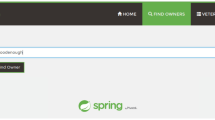Abstract
Currently, software tends to assume increasingly critical roles in our society so assuring its quality becomes ever more crucial. There are several tools and processes of software testing to help increase quality in virtually any type of software. One example is the so called model-based testing (MBT) tools, that generate test cases from models. Pattern Based Graphical User Interface Testing (PBGT) is an example of a MBT new methodology that aims at systematizing and automating the Graphical User Interface (GUI) testing process. It is supported by a Tool (PBGT Tool) which provides an integrated modeling and testing environment for crafting test models based on User Interface Test Patterns (UITP) using a GUI modeling Domain Specific Language (DSL) called PARADIGM. Most of the MBT tools have a configuration phase, where test input data is provided manually by the tester, which influences the quality of the test suite generated. By adding coverage analysis to MBT tools, it is possible to give feedback and help the tester to define the configuration data needed to achieve the most valuable test suite as possible and, ultimately, contribute for increasing the quality of the software. This paper presents a multidimensional test coverage analysis approach and tool (PARADIGM-COV), developed in the context of the PBGT project, that produces coverage information both over the PARADIGM model elements and during test case execution (to identify the parts of the model that were actually exercised). It also presents a case study illustrating the benefits of having multidimensional analysis and assessing the overall test coverage approach.














Similar content being viewed by others
References
Weyuker, E.J.: Axiomatizing software test data adequacy. IEEE Trans. Softw. Eng. 12, 1128–1138 (1986)
El-Far, I.K., Whittaker, J.A.: Model-based software testing. In: Marciniak, J.J. (ed.) Encyclopedia of Software Engineering. Wiley, New York (2002)
Eslamimehr, M.M.: The survey of model based testing and industrial tools. Master’s Thesis, Linköping University (2008)
Vilela, L., Paiva, A.C.R.: PARADIGM-COV—a multimensional test coverage analysis tool. In: CISTI 2014—9 Conferencia Ibrica de Sistemas y Tecnologas de Informacin, Barcelona, 18–21 Junio 2014
Moreira, R.M.L.M., Paiva, A.C.R.: A GUI modeling DSL for Pattern-Based GUI Testing PARADIGM. In: Maciaszek, L.A., Filipe, J. (eds.) Proceedings of the 8th International Conference on Evaluation of Novel Approaches to Software Engineering (ENASE). SciTePress, Lisbon (2014)
Batchu, R., Dandass, Y.S., Skjellum, A., Beddhu, M.: MPI/FT: a model-based approach to low-overhead fault tolerant message-passing middleware. Clust. Comput. 7(4), 303–315 (2004)
Stankovski, V., Petcu, D.: Developing a model driven approach for engineering applications based on mOSAIC. Clust. Comput. 17(1), 101–110 (2014)
Stobie, K.: Model based testing in practice at Microsoft. Electron. Notes Theor. Comput. Sci. 111, 5–12 (2005)
Grieskamp, W., Kicillof, N., Stobie, K., Braberman, V.: Model-based quality assurance of protocol documentation: tools and methodology. Softw. Test. Verif. Reliab. 21, 55–71 (2011)
Pretschner, A.: Model-based testing. In: Proceedings of 27th International Conference on Software Engineering, 2005 (ICSE 2005), pp. 722–723 (2005)
Weißleder, S.: Simulated satisfaction of coverage criteria on UML state machines. In: 2010 Third International Conference on Software Testing, Verification and Validation (ICST), pp. 117–126 (2010)
Weißleder, S.: Coverage Simulator. http://covsim.sourceforge.net/. Accessed Oct 2016
Weißleder, S., Rogenhofer, T.: Simulated restriction of coverage criteria on UML state machines. In: 2011 IEEE Fourth International Conference on Software Testing, Verification and Validation Workshops (ICSTW), pp. 34–38, March 2011
Weißleder, S.: Test models and coverage criteria for automatic model-based test generation with UML state machines. PhD Thesis, Humboldt-University Berlin (2010)
Veanes, M., Campbell, C., Grieskamp, W., Schulte, W., Tillmann, N., Nachmanson, L.: Model-based testing of object-oriented reactive systems with spec explorer. In: Hierons, R.M., Bowen, J.P., Harman, M. (eds.) Formal Methods and Testing, p. 3976. Springer, Berlin (2008)
Shafique, M., Labiche, Y.: A systematic review of model based testing tool support. Technical Report SCE-10-04. Department of Systems and Computer Engineering, Carleton University, Ottawa (2010)
Huima, A.: Implementing conformiq Qtronic. In: Petrenko, A., Veanes, M., Tretmans, J., Grieskamp, W. (eds.) Testing of Software and Communicating Systems, p. 112. Springer, Berlin (2007)
Andrade, F.R., Faria, J.P., Paiva, A.C.R.: Test generation from bounded algebraic specifications using alloy. In: ICSOFT (2), pp. 192–200 (2011)
Andrade, F.R., Faria, J.P., Lopes, A., Paiva, A.C.R.: Specification-driven unit test generation for Java Generic Classes. In: Derrick, J., Gnesi, S., Latella, D., Treharne, H. (eds.) Integrated Formal Methods, pp. 296–311. Springer, Berlin (2012)
IBM: Safety-related software development using a model-based testing workflow. http://www.ibm.com/developerworks/rational/library/safety-related-software-development/index.html. Accessed Oct 2016
Moreira, R., Paiva, A.C.R., Memon, A.: A pattern-based approach for GUI modelling and testing. In: The 24th IEEE International Symposium on Software Reliability Engineering—ISSRE (2013)
Sacramento, C., Paiva, A.C.R.: Web application model generation through reverse engineering and UI pattern inferring. In: Proceedings of the 9th International Conference on the Quality of Information and Communications Technology—QUATIC, Guimares, Portugal, 23–26 Sept 2014
Nabuco, M., Paiva, A.C.R.: Model-based test case generation for web applications. In: 14th International Conference Computational Science and Its Applications—ICCSA 2014, pp. 248–262 (2014)
Paiva, A.C.R., Faria, J., Tillmann, N., Vidal, R.: A model-to-implementation mapping tool for automated model-based GUI testing. In: 7th International Conference on Formal Engineering Methods—ICFEM, vol. 3785, pp. 450–464, UK, 1–4 Nov 2005
Author information
Authors and Affiliations
Corresponding author
Rights and permissions
About this article
Cite this article
Paiva, A.C.R., Vilela, L. Multidimensional test coverage analysis: PARADIGM-COV tool. Cluster Comput 20, 633–649 (2017). https://doi.org/10.1007/s10586-017-0728-4
Received:
Revised:
Accepted:
Published:
Issue Date:
DOI: https://doi.org/10.1007/s10586-017-0728-4




